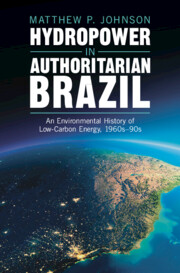129 results
Chapter 2 - The Power of the State
-
- Book:
- The Quest for Individual Freedom
- Published online:
- 12 April 2025
- Print publication:
- 10 April 2025, pp 56-99
-
- Chapter
- Export citation
Academic Freedom under Dictatorship in Chile: Coalition Building and Inter-Stakeholder Collaboration from 1980 to 1989
-
- Journal:
- History of Education Quarterly , First View
- Published online by Cambridge University Press:
- 21 March 2025, pp. 1-23
-
- Article
- Export citation
Foreign aid, FDI and the personalization of power in autocracies
-
- Journal:
- Political Science Research and Methods , First View
- Published online by Cambridge University Press:
- 21 March 2025, pp. 1-17
-
- Article
-
- You have access
- Open access
- HTML
- Export citation
4 - The Origins of Criminalized Governance
-
- Book:
- Inside Criminalized Governance
- Published online:
- 06 February 2025
- Print publication:
- 13 February 2025, pp 97-135
-
- Chapter
- Export citation
Beyond Order and Progress: Legitimacy and Nation-Building in Military Brazil
-
- Journal:
- Comparative Studies in Society and History / Volume 67 / Issue 1 / January 2025
- Published online by Cambridge University Press:
- 25 October 2024, pp. 169-196
-
- Article
-
- You have access
- Open access
- HTML
- Export citation

Hydropower in Authoritarian Brazil
- An Environmental History of Low-Carbon Energy, 1960s–90s
-
- Published online:
- 09 July 2024
- Print publication:
- 27 June 2024
1 - Setting the Scene
-
- Book:
- Hydropower in Authoritarian Brazil
- Published online:
- 09 July 2024
- Print publication:
- 27 June 2024, pp 15-45
-
- Chapter
-
- You have access
- HTML
- Export citation
4 - Imperial Expansion and Restrictive Elections: 1850–1945
-
- Book:
- Colonial Origins of Democracy and Dictatorship
- Published online:
- 08 May 2024
- Print publication:
- 30 May 2024, pp 90-127
-
- Chapter
- Export citation
2 - A Theory of Colonial Electoral Institutions
-
- Book:
- Colonial Origins of Democracy and Dictatorship
- Published online:
- 08 May 2024
- Print publication:
- 30 May 2024, pp 25-49
-
- Chapter
- Export citation
6 - Postcolonial Persistence
-
- Book:
- Colonial Origins of Democracy and Dictatorship
- Published online:
- 08 May 2024
- Print publication:
- 30 May 2024, pp 157-193
-
- Chapter
- Export citation
7 - Conclusion
-
- Book:
- Colonial Origins of Democracy and Dictatorship
- Published online:
- 08 May 2024
- Print publication:
- 30 May 2024, pp 194-206
-
- Chapter
- Export citation
5 - Mass Franchise Expansion after 1945
-
- Book:
- Colonial Origins of Democracy and Dictatorship
- Published online:
- 08 May 2024
- Print publication:
- 30 May 2024, pp 128-156
-
- Chapter
- Export citation
1 - Introduction
-
- Book:
- Colonial Origins of Democracy and Dictatorship
- Published online:
- 08 May 2024
- Print publication:
- 30 May 2024, pp 1-24
-
- Chapter
- Export citation
3 - Representation in Settler Colonies through 1850
-
- Book:
- Colonial Origins of Democracy and Dictatorship
- Published online:
- 08 May 2024
- Print publication:
- 30 May 2024, pp 50-89
-
- Chapter
- Export citation
Chapter 18 - Emancipation: Twentieth-Century Female Writers, Journalists, and Activists
- from Part II - Critical Inroads
-
-
- Book:
- A History of Argentine Literature
- Published online:
- 09 May 2024
- Print publication:
- 16 May 2024, pp 272-285
-
- Chapter
- Export citation
Chapter 9 - 1980: Memory and the Novel
- from Part I - Literary Dates
-
-
- Book:
- A History of Argentine Literature
- Published online:
- 09 May 2024
- Print publication:
- 16 May 2024, pp 133-146
-
- Chapter
- Export citation

Colonial Origins of Democracy and Dictatorship
-
- Published online:
- 08 May 2024
- Print publication:
- 30 May 2024
Carrying the Cross: Popular Christian Communities and Religious Protest during Pinochet's Dictatorship, 1973–90
-
- Journal:
- Journal of Latin American Studies / Volume 56 / Issue 2 / May 2024
- Published online by Cambridge University Press:
- 02 May 2024, pp. 253-278
- Print publication:
- May 2024
-
- Article
-
- You have access
- Open access
- HTML
- Export citation
Memory Scripts and Life History in the Shadow of Brazil's Dictatorship
-
- Journal:
- Journal of Latin American Studies / Volume 56 / Issue 2 / May 2024
- Published online by Cambridge University Press:
- 03 June 2024, pp. 279-303
- Print publication:
- May 2024
-
- Article
-
- You have access
- Open access
- HTML
- Export citation
2 - A Theory of Elite Cohesion, Coercive Capacity, and Authoritarian Social Order
- from Part I - Introduction and Theory
-
- Book:
- Watching the Watchers
- Published online:
- 22 February 2024
- Print publication:
- 29 February 2024, pp 45-90
-
- Chapter
- Export citation


